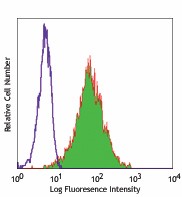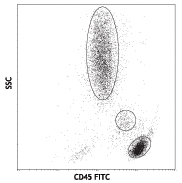- Clone
- 104D2 (See other available formats)
- Regulatory Status
- RUO
- Other Names
- Stem cell factor receptor, c-kit, mast cell growth factor receptor, steel factor receptor
- Isotype
- Mouse IgG1, κ
- Ave. Rating
- Submit a Review
- Product Citations
- publications

-

Human erythroleukemia cell line TF-1 stained with 104D2 PE -

Confocal image of human skin sample acquired using the IBEX method of highly multiplexed antibody-based imaging: CD117 (magenta) in Cycle 3, CD138 (cyan) in Cycle 4, and Vimentin (blue) in Cycle 5. Tissues were prepared using ~1% (vol/vol) formaldehyde and a detergent. Following fixation, samples are immersed in 30% (wt/vol) sucrose for cryoprotection. Images are courtesy of Drs. Andrea J. Radtke and Ronald N. Germain of the Center for Advanced Tissue Imaging (CAT-I) in the National Institute of Allergy and Infectious Diseases (NIAID, NIH).
| Cat # | Size | Price | Quantity Check Availability | Save | ||
|---|---|---|---|---|---|---|
| 313203 | 25 tests | $108 | ||||
| 313204 | 100 tests | $232 | ||||
CD117 is a 145 kD protein tyrosine kinase also known as c-Kit. It is a receptor for stem cell factor or c-Kit ligand. CD117 is expressed on pluripotent hematopoietic progenitor cells (approximately 1-4% bone marrow cells), mast cells, and acute myeloid leukemia cells (AML). CD117 binding of c-Kit ligand induces phosphorylation of CD117 and stimulates proliferation and survival of primitive hematopoietic stem cells as well as erythroid-committed and granulo-monocytic committed cells.
Product DetailsProduct Details
- Reactivity
- Human
- Antibody Type
- Monoclonal
- Host Species
- Mouse
- Immunogen
- MOLM-1 megakaryocytic cell line
- Formulation
- Phosphate-buffered solution, pH 7.2, containing 0.09% sodium azide and BSA (origin USA)
- Preparation
- The antibody was purified by affinity chromatography, and conjugated with PE under optimal conditions.
- Concentration
- Lot-specific (to obtain lot-specific concentration and expiration, please enter the lot number in our Certificate of Analysis online tool.)
- Storage & Handling
- The CD117 antibody solution should be stored undiluted between 2°C and 8°C, and protected from prolonged exposure to light. Do not freeze.
- Application
-
FC - Quality tested
SB - Reported in the literature, not verified in house - Recommended Usage
-
Each lot of this antibody is quality control tested by immunofluorescent staining with flow cytometric analysis. For flow cytometric staining, the suggested use of this reagent is 5 µl per million cells in 100 µl staining volume or 5 µl per 100 µl of whole blood.
- Excitation Laser
-
Blue Laser (488 nm)
Green Laser (532 nm)/Yellow-Green Laser (561 nm)
- Application Notes
-
The 104D2 antibody does not block binding of c-Kit ligand. Additional reported applications (for the relevant formats) include: immunoprecipitation1, immunofluorescence microscopy1, and spatial biology (IBEX)4,5.
- Additional Product Notes
-
Iterative Bleaching Extended multi-pleXity (IBEX) is a fluorescent imaging technique capable of highly-multiplexed spatial analysis. The method relies on cyclical bleaching of panels of fluorescent antibodies in order to image and analyze many markers over multiple cycles of staining, imaging, and, bleaching. It is a community-developed open-access method developed by the Center for Advanced Tissue Imaging (CAT-I) in the National Institute of Allergy and Infectious Diseases (NIAID, NIH).
-
Application References
(PubMed link indicates BioLegend citation) - Product Citations
- RRID
-
AB_314982 (BioLegend Cat. No. 313203)
AB_314983 (BioLegend Cat. No. 313204)
Antigen Details
- Structure
- Growth factor receptor with tyrosine kinase activity, subclass III, approximately 145 kD
- Distribution
-
Pluripotent hematopoietic progenitor cells (approximately 1-4% bone marrow cells), mast cells, acute myeloid leukemic cells (AML)
- Function
- Growth factor receptor for stem cell factor. Induces proliferation and survival of primitive hematopoietic progenitors. Potent inducer of proliferation in erythroid-committed progenitor cells. Defects in CD117 have been linked to severe anemia and a decreased number of hematopoietic progenitor cells.
- Ligand/Receptor
- c-Kit ligand
- Modification
- Multiple phosphorylation sites
- Cell Type
- Embryonic Stem Cells, Hematopoietic stem and progenitors, Leukemia, Mast cells, Mesenchymal Stem Cells
- Biology Area
- Immunology, Stem Cells
- Molecular Family
- CD Molecules
- Antigen References
-
1. Giebel LB, et al. 1992. Oncogene 7:2207.
2. Furitsu T, et al. 1993. J. Clin. Invest. 92:1736. - Gene ID
- 3815 View all products for this Gene ID
- UniProt
- View information about CD117 on UniProt.org
Related FAQs
- What type of PE do you use in your conjugates?
- We use R-PE in our conjugates.
- If an antibody clone has been previously successfully used in IBEX in one fluorescent format, will other antibody formats work as well?
-
It’s likely that other fluorophore conjugates to the same antibody clone will also be compatible with IBEX using the same sample fixation procedure. Ultimately a directly conjugated antibody’s utility in fluorescent imaging and IBEX may be specific to the sample and microscope being used in the experiment. Some antibody clone conjugates may perform better than others due to performance differences in non-specific binding, fluorophore brightness, and other biochemical properties unique to that conjugate.
- Will antibodies my lab is already using for fluorescent or chromogenic IHC work in IBEX?
-
Fundamentally, IBEX as a technique that works much in the same way as single antibody panels or single marker IF/IHC. If you’re already successfully using an antibody clone on a sample of interest, it is likely that clone will have utility in IBEX. It is expected some optimization and testing of different antibody fluorophore conjugates will be required to find a suitable format; however, legacy microscopy techniques like chromogenic IHC on fixed or frozen tissue is an excellent place to start looking for useful antibodies.
- Are other fluorophores compatible with IBEX?
-
Over 18 fluorescent formats have been screened for use in IBEX, however, it is likely that other fluorophores are able to be rapidly bleached in IBEX. If a fluorophore format is already suitable for your imaging platform it can be tested for compatibility in IBEX.
- The same antibody works in one tissue type but not another. What is happening?
-
Differences in tissue properties may impact both the ability of an antibody to bind its target specifically and impact the ability of a specific fluorophore conjugate to overcome the background fluorescent signal in a given tissue. Secondary stains, as well as testing multiple fluorescent conjugates of the same clone, may help to troubleshoot challenging targets or tissues. Using a reference control tissue may also give confidence in the specificity of your staining.
- How can I be sure the staining I’m seeing in my tissue is real?
-
In general, best practices for validating an antibody in traditional chromogenic or fluorescent IHC are applicable to IBEX. Please reference the Nature Methods review on antibody based multiplexed imaging for resources on validating antibodies for IBEX.
Customers Also Purchased
Compare Data Across All Formats
This data display is provided for general comparisons between formats.
Your actual data may vary due to variations in samples, target cells, instruments and their settings, staining conditions, and other factors.
If you need assistance with selecting the best format contact our expert technical support team.
 Login/Register
Login/Register 

















Follow Us